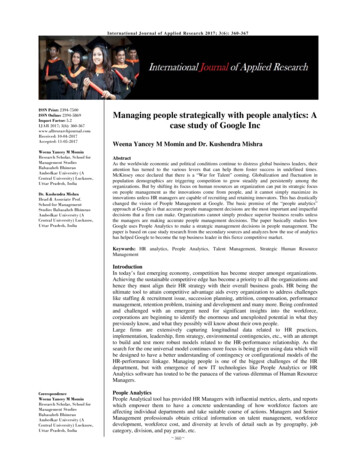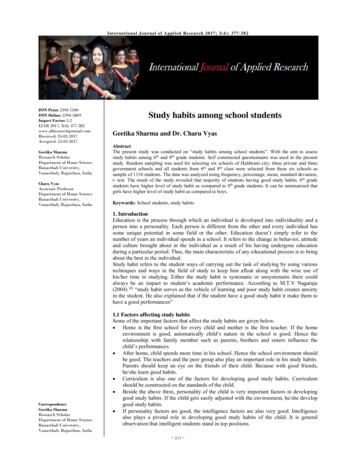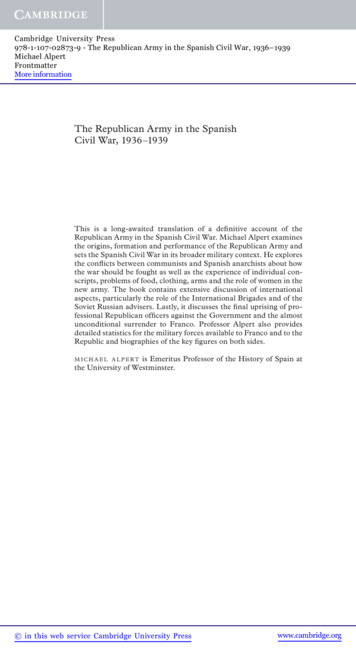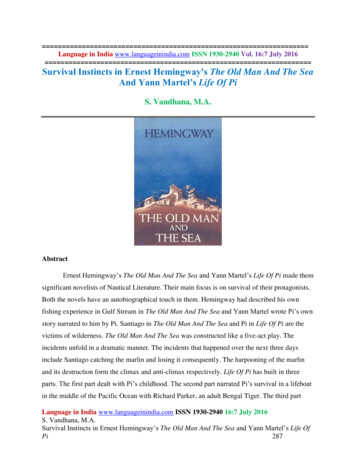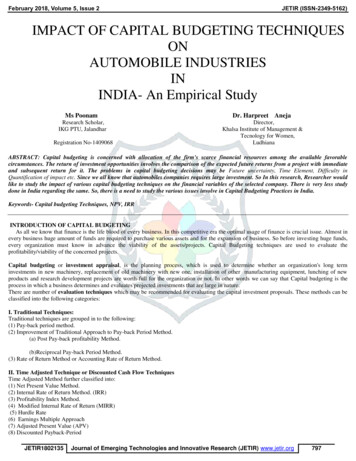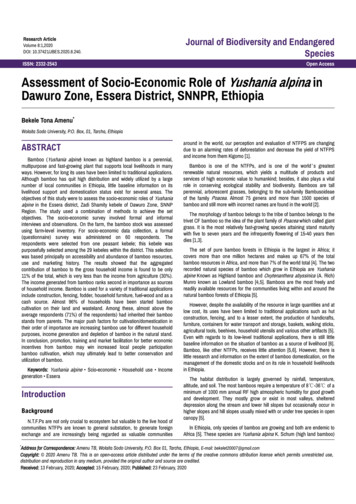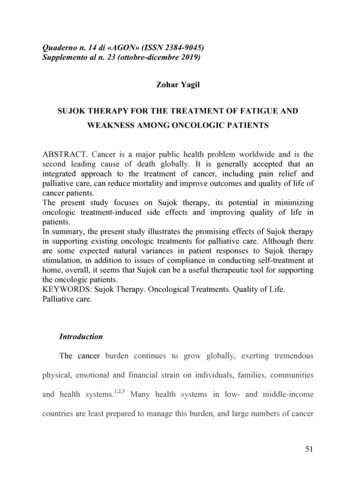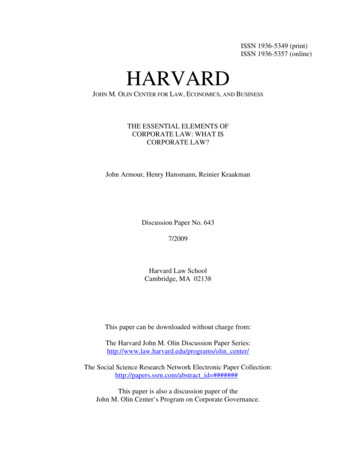
Transcription
ISSN 1936-5349 (print)ISSN 1936-5357 (online)HARVARDJOHN M. OLIN CENTER FOR LAW, ECONOMICS, AND BUSINESSTHE ESSENTIAL ELEMENTS OFCORPORATE LAW: WHAT ISCORPORATE LAW?John Armour, Henry Hansmann, Reinier KraakmanDiscussion Paper No. 6437/2009Harvard Law SchoolCambridge, MA 02138This paper can be downloaded without charge from:The Harvard John M. Olin Discussion Paper Series:http://www.law.harvard.edu/programs/olin center/The Social Science Research Network Electronic Paper Collection:http://papers.ssrn.com/abstract id #######This paper is also a discussion paper of theJohn M. Olin Center’s Program on Corporate Governance.
The Essential Elements of Corporate LawWhat is Corporate Law?John ArmourUniversity of Oxford - Faculty of Law;Oxford-Man Institute of Quantitative Finance;European Corporate Governance Institute (ECGI)Henry HansmannYale Law School;European Corporate Governance Institute (ECGI)Reinier KraakmanHarvard Law School;John M. Olin Center for Law;European Corporate Governance InstituteAbstract: This article is the first chapter of the second edition of The Anatomy of CorporateLaw: A Comparative and Functional Approach, by Reinier Kraakman, John Armour, PaulDavies, Luca Enriques, Henry Hansmann, Gerard Hertig, Klaus Hopt, Hideki Kanda andEdward Rock (Oxford University Press, 2009). The book as a whole provides a functionalanalysis of corporate (or company) law in Europe, the U.S., and Japan. Its organizationreflects the structure of corporate law across all jurisdictions, while individual chapters explorethe diversity of jurisdictional approaches to the common problems of corporate law. In itssecond edition, the book has been significantly revised and expanded.As the book's introductory chapter, this article describes the functions and boundaries ofcorporate law. We first detail the economic importance of the corporate form's hallmarkfeatures: legal personality, limited liability, transferable shares, delegated management, andinvestor ownership. We then identify the major agency problems that attend the corporateform, and that, therefore, corporate law must address: conflicts between managers andshareholders, between controlling and minority shareholders, and between shareholders as aclass and non-shareholder constituencies of the firm such as creditors and employees. In ourview, corporate law serves in part to accommodate contract and property law to the corporateform and, in substantial part, to address the agency problems that are associated with thisform. We next consider the role of law in structuring corporate affairs so as to achieve thesegoals: whether, and to what extent standard forms - as opposed, on the one hand, to privatecontract, and on the other, to mandatory rules - are needed, and the role of regulatorycompetition. Whilst the ‘core’ features of corporate law are present in all - or almost all - legalsystems, different systems have made different choices regarding the form and content ofmany other aspects of their corporate laws. To assist in explaining these, we review a rangeof forces that shape the development of corporate law, including domestic share ownershippatterns. These forces operate differently across countries, implying that in some cases,complementary differences in corporate laws are functional. However, other such differencesmay be better explained as a response to purely distributional concerns.JEL Classifications: D23, G32, G34, G38, K22, M141
1 What is Corporate Law? 2009 JOHN ARMOUR, HENRY HANSMANN, andREINIER KRAAKMAN1.1 INTRODUCTIONWhat is the common structure of the law of business corporations—or, as it would beput in some jurisdictions, company law—across different national jurisdictions?Although this question is rarely asked by corporate law scholars, it is criticallyimportant for the comparative investigation of corporate law. Recent scholarship oftenemphasizes the divergence among European, American, and Japanese corporations incorporate governance, share ownership, capital markets, and business culture. 1 But,notwithstanding the very real differences across jurisdictions along these dimensions,the underlying uniformity of the corporate form is at least as impressive. Businesscorporations have a fundamentally similar set of legal characteristics—and face afundamentally similar set of legal problems—in all jurisdictions.Consider, in this regard, the basic legal characteristics of the businesscorporation. To anticipate our discussion below, there are five of these characteristics,most of which will be easily recognizable to anyone familiar with business affairs.They are: legal personality, limited liability, transferable shares, delegatedmanagement under a board structure, and investor ownership. These characteristicsrespond—in ways we will explore—to the economic exigencies of the large modernbusiness enterprise. Thus, corporate law everywhere must, of necessity, provide forthem. To be sure, there are other forms of business enterprise that lack one or moreof these characteristics. But the remarkable fact—and the fact that we wish tostress—is that, in market economies, almost all large-scale business firms adopt alegal form that possesses all five of the basic characteristics of the businesscorporation. Indeed, most small jointly-owned firms adopt this corporate form as well,although sometimes with deviations from one or more of the five basic characteristicsto fit their special needs.It follows that a principal function of corporate law is to provide businessenterprises with a legal form that possesses these five core attributes. By making thisform widely available and user-friendly, corporate law enables entrepreneurs totransact easily through the medium of the corporate entity, and thus lowers the costsof conducting business. Of course, the number of provisions that the typicalcorporation statute 2 devotes to defining the corporate form is likely to be only a smallpart of the statute as a whole. Nevertheless, these are the provisions that comprise thelegal core of corporate law that is shared by every jurisdiction. In this Chapter, we1See, e.g., Ronald J. Gilson and Mark J. Roe, Understanding the Japanese Keiretsu: Overlaps BetweenCorporation Governance and Industrial Organization, 102 YALE LAW JOURNAL 871 (1993); Mark J.Roe, Some Differences in Corporation Structure in Germany, Japan, and the United States, 102 YALELAW JOURNAL 1927 (1993); Bernard S. Black and John C. Coffee, Hail Britannia? InstitutionalInvestor Behavior Under Limited Regulation, 92 MICHIGAN LAW REVIEW 1997 (1994); COMPARATIVECORPORATE GOVERNANCE: ESSAYS AND MATERIALS (Klaus J. Hopt and Eddy Wymeersch (eds.), 1997);and Mark J. Roe, POLITICAL DETERMINANTS OF CORPORATE GOVERNANCE (2003).2We use the term ‘corporation statute’ to refer to the general law that governs corporations, and not toa corporation’s individual charter (or ‘articles of incorporation’, as that document is sometimes alsocalled).2
briefly explore the contracting efficiencies (some familiar and some not) thataccompany these five features of the corporate form, and that, we believe, havehelped to propel the worldwide diffusion of the corporate form.As with corporate law itself, however, our principal focus in this book is noton establishing the corporate form per se. Rather, it is on a second, equally importantfunction of corporate law: namely, reducing the ongoing costs of organizing businessthrough the corporate form. Corporate law does this by facilitating coordinationbetween participants in corporate enterprise, and by reducing the scope for valuereducing forms of opportunism among different constituencies. Indeed, much ofcorporate law can usefully be understood as responding to three principal sources ofopportunism: conflicts between managers and shareholders, conflicts amongshareholders, and conflicts between shareholders and the corporation’s otherconstituencies, including creditors and employees. All three of these generic conflictsmay usefully be characterized as what economists call ‘agency problems.’Consequently, Chapter 2 examines these three agency problems, both in general andas they arise in the corporate context, and surveys the range of legal strategies that canbe employed to ameliorate those problems.The reader might object that these agency conflicts are not uniquely‘corporate’. After all, any form of jointly-owned enterprise must expect conflictsamong its owners, managers, and third-party contractors. We agree; insofar as thecorporation is only one of several legal forms for the jointly-owned firm, it faces thesame generic agency problems that confront all jointly-owned firms. Nevertheless, thecharacteristics of this particular form matter a great deal, since it is the form that ischosen by most large-scale enterprises—and, as a practical matter, the only form thatfirms with widely dispersed ownership can choose in many jurisdictions. 3 Moreover,the unique features of this form determine the contours of its agency problems. Totake an obvious example, the fact that shareholders enjoy limited liability—while,say, general partners in a partnership do not—has traditionally made creditorprotection far more salient in corporate law than it is in partnership law. Similarly, thefact that corporate investors may trade their shares is the foundation of theanonymous trading stock market—an institution that has encouraged the separationof ownership from control, and so has sharpened the management-shareholderagency problem.In this book, we explore the role of corporate law in minimizing agencyproblems—and thus, making the corporate form practicable—in the most importantcategories of corporate actions and decisions. More particularly, Chapters 3–9address, respectively, seven categories of transactions and decisions that involve thecorporation, its owners, its managers, and the other parties with whom it deals.Most of these categories of firm activity are, again, generic, rather than uniquelycorporate. For example, Chapters 3 and 4 address governance mechanisms thatoperate over the firm’s ordinary business decisions, whilst Chapter 5 turns to thechecks that operate on the corporation’s transactions with creditors. As before,however, although similar agency problems arise in similar contexts across all forms of3Only the corporate form is available in many jurisdictions for firms that want access to the capitalmarkets for equity financing. Some jurisdictions, however, permit the equity of non-corporate entitiesto trade in the public markets as well: for example, in the U.S., the equity securities of so-called‘master’ limited partnerships and limited liability companies may be registered for public trading.3
jointly-owned enterprise, the response of corporate law turns in part on the uniquelegal features that characterize the corporate form.Taken together, the latter seven chapters of our book cover nearly all of theimportant problems in corporate law. In each Chapter, we describe how the basicagency problems of the corporate form manifest themselves in the given category ofcorporate activity, and then explore the range of alternative legal responses that areavailable. We illustrate these alternative approaches with examples from the corporatelaw of various prominent jurisdictions. We explore the patterns of homogeneity andheterogeneity that appear. Where there are significant differences acrossjurisdictions, we seek to address both the sources and the consequences of thosedifferences. Our examples are drawn principally from a handful of majorrepresentative jurisdictions, including France, Germany, Italy, Japan, the UK, and theU.S., though we also make reference to the laws of other jurisdictions to make specialpoints. 4In emphasizing a strongly functional approach to the issues of comparativelaw, this book differs from some of the more traditional comparative law scholarship,both in the field of corporate law and elsewhere. 5 We join an emerging tendency incomparative law scholarship by seeking to give a highly integrated view of the roleand structure of corporate law that provides a clear framework within which toorganize an understanding of individual systems, both alone and in comparison witheach other. 6 Moreover, while comparative law scholarship often has a tendency toemphasize differences between jurisdictions, our approach is to focus on similarities.Doing so, we believe, illuminates an underlying commonality of structure thattranscends national boundaries. It also provides an important perspective on thepotential basis for the international integration of corporate law that is likely to takeplace as economic activity continues to become more global in scope in the decades tocome.We realize that the term ‘functional’, which we have used here and in our title,means different things to different people, and that some of the uses to which thatterm has been put in the past—particularly in the field of sociology—have made theterm justifiably suspect. It would perhaps be more accurate to call our approach‘economic’ rather than ‘functional,’ though the sometimes tendentious use ofeconomic argumentation in legal literature to support particular (generally laissezfaire) policy positions, as well as the tendency in economic analysis to neglect nonpecuniary motivations or assume an unrealistic degree of rationality in human action,4We focus on developed, rather than developing, economies, because where foundational legalinstitutions, such as functioning courts and the protection of property rights, are absent orcompromised, then the way in which corporate law responds to specific problems is less likely to makea difference to the real economy. A discussion of the ways in which such institutions can beengendered, or replicated by extra-legal means, is beyond the scope of our enquiry.5Compare, e.g., Arthur R. Pinto and Gustavo Visentini (eds.), THE LEGAL BASIS OF CORPORATEGOVERNANCE IN PUBLICLY HELD CORPORATIONS, A COMPARATIVE APPROACH 1998).6Other examples of this trend include Dennis C. Mueller and B. Burcin Yurtoglu, Country LegalEnvironments and Corporate Investment Performance, 1 GERMAN ECONOMIC REVIEW 187 (2000);Rafael La Porta, Florencio Lopez-de-Silanes, Andrei Shleifer and Robert W. Vishny, Law and Finance,106 JOURNAL OF POLITICAL ECONOMY 1113 (1998); Henry Hansmann and Ugo Mattei, The Functionsof Trust Law: A Comparative Legal and Economic Analysis, 73 NEW YORK UNIVERSITY LAW REVIEW434 (1998); Curtis Milhaupt and Katharina Pistor, LAW AND CAPITALISM (2008); Konrad Zweigert andHein Kötz, INTRODUCTION TO COMPARATIVE LAW (Tony Weir trans., 3rd ed. 1998); Ugo Mattei,COMPARATIVE LAW AND ECONOMICS (1997).4
have also caused many scholars—particularly outside of the United States—to be aswary of ‘economic analysis’ as they are of ‘functional analysis.’ For the purposes athand, however, we need not commit ourselves on fine points of social sciencemethodology. We need simply note that the exigencies of commercial activity andorganization present practical problems that have a rough similarity in developedmarket economies throughout the world. Our analysis is ‘functional’ in the sense thatwe organize discussion around the ways in which corporate laws respond to theseproblems, and the various forces that have led different jurisdictions to chooseroughly similar—though by no means always the same—solutions to them.That is not to say that our objective here is just to explore the commonality ofcorporate law across jurisdictions. Of equal importance, we wish to offer a commonlanguage and a general analytic framework with which to understand the purposesthat can potentially be served by corporate law, and with which to compare andevaluate the efficacy of different legal regimes in serving those purposes. 7 Indeed, it isour hope that the analysis offered in this book will be of use not only to students ofcomparative law, but also to those who simply wish to have a more solid frameworkwithin which to view their own country’s corporation law.Likewise, we take no strong stand here in the current debate on the extent towhich corporate law is or should be ‘converging,’ much less on what it mightconverge to. 8 That is a subject on which reasonable minds can differ. Indeed, it is asubject on which the reasonable minds that have written this book sometimes differ. 9Rather, we are seeking to set out a conceptual framework and a factual basis withwhich that and other important issues facing corporate law can be fruitfullyexplored.7In very general terms, our approach echoes that taken by Dean Robert Clark in his important treatise,CORPORATE LAW (1986), and Frank Easterbrook and Daniel Fischel, in their discussion of U.S. law,THE ECONOMIC STRUCTURE OF CORPORATE LAW (1991). However, our analysis differs from—andgoes beyond—that offered by these and other commentators in several key respects. First, and mostobviously, we present a comparative analysis that addresses the corporate law of multiple jurisdictions.Second, we provide an integrated functional overview that stresses the agency problems at the core ofcorporate law, rather than focusing on more particular legal institutions and solutions. Finally, we offera more expansive account than do other commentators of the functions of central features of thecorporate form such as limited liability and the governance structure of the corporate board. Ouranalysis, moreover, is informed not only by a comparative perspective across jurisdictions, but also,occasionally, by a comparative perspective across legal forms for business enterprise.8Compare Lucian A. Bebchuk and Mark J. Roe, A Theory of Path Dependence in CorporateOwnership and Governance, 52 STANFORD LAW REVIEW 127 (1999); William M. Bratton and Joseph A.McCahery, Comparative Corporate Governance and the Theory of the Firm: The Case AgainstGlobal Cross Reference, 38 COLUMBIA JOURNAL OF TRANSNATIONAL LAW 213 (1999); John C.Coffee, The Future as History: The Prospects for Global Convergence in Corporate Governance andits Significance, 93 NORTHWESTERN UNIVERSITY LAW REVIEW 641 (1999); Ronald J. Gilson,Globalizing Corporate Governance: Convergence of Form or Function, 49 AMERICAN JOURNAL OFCOMPARATIVE LAW 329 (2001); Amir N. Licht, The Mother of All Path Dependencies: Toward a CrossCultural Theory of Corporate Governance Systems, 26 DELAWARE JOURNAL OF CORPORATE LAW 147(2001); Mathias M. Siems, CONVERGENCE IN SHAREHOLDER LAW (2007).9The views of the authors of this chapter are briefly set out in Henry Hansmann and ReinierKraakman, The End of History for Corporate Law, 89 GEORGETOWN LAW JOURNAL 439 (2001) andJohn Armour and Jeffrey N. Gordon, The Berle-Means Corporation in the Twenty-First Century,Working Paper (2008), at http://www.law.upenn.edu.5
1.2 WHAT IS A CORPORATION?As we noted above, the five core structural characteristics of the business corporationare: (1) legal personality, (2) limited liability, (3) transferable shares, (4) centralizedmanagement under a board structure, and (5) shared ownership by contributors ofcapital. In virtually all economically important jurisdictions, there is a basic statutethat provides for the formation of firms with all of these characteristics. As thispattern suggests, these characteristics have strongly complementary qualities formany firms. Together, they make the corporation uniquely attractive for organizingproductive activity. But these characteristics also generate tensions and tradeoffs thatlend a distinctively corporate character to the agency problems that corporate lawmust address.1.2.1 Legal personalityIn the economics literature, a firm is often characterized as a ‘nexus of contracts’. Ascommonly used, this description is ambiguous. It is often invoked simply toemphasize that most of the important relationships within a firm—including, inparticular, those among the firm’s owners, managers, and employees—are essentiallycontractual in character, and hence based on consent, rather than involving some formof extracontractual command-and-control authority. This is an important insight, but itdoes not distinguish firms from other networks of contractual relationships. It isperhaps more accurate to describe a firm as a ‘nexus for contracts’, in the sense that afirm serves, fundamentally, as the common counterparty in numerous contracts withsuppliers, employees, and customers, coordinating the actions of these multiple personsthrough exercise of its contractual rights. 10 The first and most important contributionof corporate law, as of other forms of organizational law, is to permit a firm to servethis role by permitting the firm to serve as a single contracting party that is distinctfrom the various individuals who own or manage the firm. In so doing, it enhancesthe ability of these individuals to engage together in joint projects.The core element of the firm as a nexus for contracts is what the civil law refersto as ‘separate patrimony.’ This involves the demarcation of a pool of assets that aredistinct from other assets owned, singly or jointly, by the firm’s owners (theshareholders), 11 and of which the firm in itself, acting through its designatedmanagers, is viewed in law as being the owner. The firm’s rights of ownership overits designated assets include the rights to use the assets, to sell them, and—ofparticular importance—to make them available for attachment by its creditors.Conversely, because these assets are conceived as belonging to the firm, rather thanthe firm’s owners, they are unavailable for attachment by the personal creditors ofthese persons. The core function of this separate patrimony has been termed ‘entity10The characterization of a firm as a ‘nexus of contracts’ originates with Michael Jensen and WilliamMeckling, Theory of the Firm: Managerial Behavior, Agency Costs and Ownership Structure, 3JOURNAL OF FINANCIAL ECONOMICS 305 (1976), building on Armen Alchian and Harold Demsetz,Production, Information Costs, and Economic Organization, 62 AMERICAN ECONOMIC REVIEW 777(1972).11We use the term ‘owners’ simply to refer to the group who have the entitlement to control the firm’sassets.6
shielding,’ to emphasize that it involves shielding the assets of the entity—thecorporation—from the creditors of the entity’s owners. 12Where corporations are concerned, entity shielding involves two relativelydistinct rules of law. The first is a priority rule that grants to creditors of the firm, assecurity for the firm’s debts, a claim on the firm’s assets that is prior to the claims ofthe personal creditors of the firm’s owners. This rule is shared by all modern legalforms for enterprise organization, including partnerships. 13 The consequence of thispriority rule is that a firm’s assets are, as a default rule of law, 14 automatically madeavailable for the enforcement of contractual liabilities entered into in the name of thefirm. 15 By thus bonding the firm’s contractual commitments, the rule makes thesecommitments credible.The second component of entity shielding—a rule of ‘liquidationprotection’—provides that the individual owners of the corporation (the shareholders)cannot withdraw their share of firm assets at will, thus forcing partial or completeliquidation of the firm, nor can the personal creditors of an individual owner forecloseon the owner’s share of firm assets. 16 This liquidation protection rule serves to protectthe going concern value of the firm against destruction either by individualshareholders or their creditors. 17 In contrast to the priority rule just mentioned, it isnot found in some other standard legal forms for enterprise organization, such as thepartnership. 18 Legal entities, such as the business corporation, that are characterizedby both these rules—priority for business creditors and liquidation protection—cantherefore be thought of as having ‘strong form’ entity shielding, as opposed to the‘weak form’ entity shielding found in partnerships, which are characterized only bythe priority rule and not by liquidation protection.For a firm to serve effectively as a contracting party, two other types of rulesare also needed. First, there must be rules specifying to third parties the individualswho have authority to buy and sell assets in the name of the firm, and to enter intocontracts that are bonded by those assets. 19 Whilst of course participants in a firm arefree to specify the delegation of authority by contract amongst themselves,12The term ‘entity shielding’ derives from Henry Hansmann, Reinier Kraakman and Richard Squire,Law and the Rise of the Firm, 119 HARVARD LAW REVIEW 1333 (2006). The centrality of entityshielding to organizational law is explored in Henry Hansmann and Reinier Kraakman, The EssentialRole of Organizational Law, 110 YALE LAW JOURNAL 387 (2000), where the attribute was labelled‘affirmative asset partitioning’.13While even unregistered common law partnerships are subject to this priority rule, the civil lawrecognizes a class of unregistered ‘partnerships’ that lack this rule of priority. In effect, suchpartnerships are just special forms for co-ownership of assets rather than distinct entities for purposesof contracting.14On default rules, see Section 1.4.1 infra.15The effect is the same as if the firm’s owners had themselves entered into a joint contract and grantednon-recourse security over certain personal assets to the counterparty, as opposed to transferring thoseassets to the corporate patrimony, and then procuring the company to enter into the contract.16Hansmann and Kraakman, supra note 12, at 411–13.17Edward B. Rock and Michael L. Wachter, Waiting for the Omelet to Set: Match-Specific Assets andMinority Oppression in Close Corporations, 24 JOURNAL OF CORPORATION LAW 913, 918–20 (1999);Margaret M. Blair, Locking in Capital: What Corporate Law Achieved for Business Organizers in theNineteenth Century, 51 UCLA LAW REVIEW 387, 441–9 (2003).18However, it is possible in many jurisdictions to effect liquidation protection by agreement amongstthe owners of a partnership.19John Armour and Michael J. Whincop, The Proprietary Foundations of Corporate Law, 27 OXFORDJOURNAL OF LEGAL STUDIES 429, 441–2 (2007).7
background rules are needed—beyond such contractual agreement—to deal withsituations where agents induce third parties to rely on the mere appearance of theirauthority. Such rules differ according to organizational form. The particular rules ofauthority that characterize the corporation are treated below as a separate corecharacteristic, ‘delegated management’. They provide that a board of directors, asopposed to individual owners, has power to bind the company in contract. 20Second, there must be rules specifying the procedures by which both the firmand its counterparties can bring lawsuits on the contracts entered into in the name ofthe firm. Corporations are subject to rules that make such suits easy to bring as aprocedural matter. In particular, they eliminate any need to name, or serve notice on,the firm’s individual owners—procedures that characterize the rules of suit that, forexample, characterized the Anglo-American partnership until the late 19th century.The outcomes achieved by each of these three types of rules—entity shielding,authority, and procedure—require dedicated legal doctrines to be effective, in the sensethat, absent such doctrine, they could not feasibly be replicated simply by contractingamong a business’s owners and their suppliers and customers. Entity shieldingdoctrine is needed to create common expectations, among a firm and its variouspresent and potential creditors, concerning the effect that a contract between a firmand one of its creditors will have on the security available to the firm’s othercreditors. 21 Rules governing the allocation of authority are needed to establishcommon expectations as to who has authority to transfer rights relating to corporateassets prior to entering into a contract for their transfer. 22 And procedures forlawsuits need to be specified by the state, whose third-party authority is invoked bythose procedures. This need for special rules of law distinguishes these three types ofrules from the other basic elements of the corporate form discussed here, which couldin theory be crafted by contract even if the law did not provide for a standard formof enterprise organization that embodies them. 23The concept of the ‘separate legal personality’ of the corporation, asunderstood in the legal literature, is in our terms a convenient heuristic formula fordescribing organizational forms which enjoy the benefit of each of the three foregoing‘foundational’ rule types. Starting from the premise that the company is itself aperson, in the eyes of the law, it is straightforward to deduce that it should be capableof entering into contracts and owning its own property; capable of delegatingauthority to agents; and capable of suing and being sued in its own name. Forexpository convenience, we use the term ‘legal personality’ to refer to organizational20Associated rules—such as the doctrine of ultra vires—may also prescribe limits as to the extent towhich the board may bind the company in contract.21To establish the priority of business creditors by contract, a firm’s owners would have to contract withits business creditors to include subordination provisions, with respect to business assets, in allcontracts between individual owners and individual creditors. Not only would such provisions becumbersome to draft and costly to monitor, but they would be subject to a high degree of moralhazard—an individual owner could breach her promise to subordinate the claims of her personalcreditors on the firm’s assets with impunity, since this promise would be unenforceable against personalcreditors who were not party to the bargain. See Hansmann and Kraakman, supra note 12, at 407–9.22To leave questions of authority to be determined simply by agreement between the owners of thefirm wi
Law: A Comparative and Functional Approach, by Reinier Kraakman, John Armour, Paul Davies, Luca Enriques, Henry Hansmann, Gerard Hertig, Klaus Hopt, Hideki Kanda and Edward Rock (Oxford University Press, 2009). The book as a whole provides a functional analysis of corporate (or company) law
